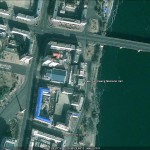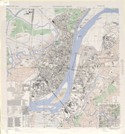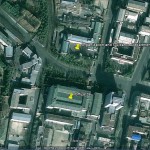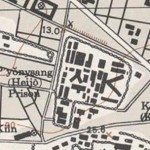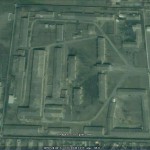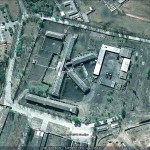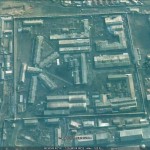UPDATE 18 (11/08/2010): South Korean aid will finally be delivered to the DPRK on 11/09. Here is more from the PRC’s People’s Daily:
Some of South Korea’s first government-financed rice aid in almost three years will be delivered to the flood-hit Democratic People’s Republic of Korea ( DPRK) starting Tuesday, the unification ministry said Monday.
Some of the 5,000 tons of rice currently in the Chinese city of Dandong will be sent to the northwestern DPRK city of Sinuiju, a city reeling from heavy rains in August, and the delivery will be completed by the end of next week, according to the ministry.
Three million cups of instant noodles, also part of the flood aid, have already been sent to Sinuiju, while some of the pledged one million tons of cement will reach the city later in the day, the ministry said.
As he took office in 2008, South Korean President Lee Myung-bak cut a free flow of rice aid to Pyongyang, which once amounted to 300,000 to 400,000 tons each year. A hard-liner toward Pyongyang, he also ended a decade of rapprochement under his liberal predecessors by linking aid to dismantlement of the DPRK’s nuclear programs.
UPDATE 17 (1o/29/2010): Here and here are photos of the aid arriving in China.
UPDATE 16: According to the Korea Times, the shipment was delayed due to weather.
UPDATE 15: First aid shipment to go today (10/25). According to Yonhap:
A shipment of rice was to depart a South Korean port en route to North Korea Monday, which will mark Seoul’s first government-financed rice aid to the communist nation in more than two and a half years.
A cargo ship carrying 5,000 tons of rice was scheduled to depart the port city of Gunsan for the northeastern Chinese city of Dandong on the border with North Korea. Another ship was also set to head from the port of Incheon to the Chinese city, carrying 3 million packs of instant noodles.
The Red Cross aid, which is aimed at helping the North cope with the aftermath of floods, marks South Korea’s first government-funded provision of rice to the North since President Lee Myung-bak took office in early 2008 on a pledge to link aid to progress in efforts to end Pyongyang’s nuclear programs.
Seoul also plans to send a shipment of 10,000 tons of cement to the North later this week.
A total of 13.9 billion won (US$12.3 million) came from the government coffers to finance the flood aid.
Also Monday, three Red Cross officials prepared to fly to the Chinese city to receive the rice and instant noodles there and transport the relief supplies by truck to the flood-hit North Korean border city of Sinuiju, according to officials from the Red Cross and the Unification Ministry.
The cargo ships are expected to arrive in Dandong around Wednesday.
Rice will be delivered in five-kilogram packages, and each package is marked with “Donation from the Republic of Korea,” South Korea’s official name.
In August, South Korea first offered to provide relief aid to the North after devastating floods hit the communist nation. North Korea later asked for rice, heavy construction equipment and materials.
UPDATE 14: S. Korea to send rice aid to N. Korea next month. Accrording to Yonhap:
South Korea’s Red Cross will begin the shipment of 5,000 tons of rice and other aid materials next month to North Korea, which has been battered by summer floods, officials here said Sunday.
It would mark South Korea’s first government-funded provision of rice to the hunger-stricken communist neighbor since the conservative president, Lee Myung-bak, took office in early 2008 on a pledge to link inter-Korean ties to Pyongyang’s denuclearization.
The South’s government plans to convene a committee on inter-Korean exchanges on Tuesday to approve the use of taxpayers’ money earmarked for projects to improve relations with the North, the officials said.
“(The government) will report to the National Assembly on Sept. 28 and the committee will approve the aid worth 8 billion won (US$6.9 million) from the South-North Cooperation Fund (on the same day),” a Unification Ministry official said.
The rice shipment will depart from the port of Incheon, west of Seoul, on Oct. 25 and it will be delivered to the North Korean city of Sinuiju bordering China via Dandong, an adjacent Chinese town, he added.
Other aid items to be sent to the North in stages include 10,000 tons of cement, three million packs of instant noodles and some medical goods.
South Korea has ruled out the shipment of construction equipment, which the North requested, taking into account the possibility of the equipment being used for military purposes.
Seoul’s rice aid, although officials here stressed it is purely a humanitarian move, has been seen as a possible sign of a thaw in chilled inter-Korean relations. Military tensions have risen sharply since the sinking of a South Korean warship in March, which the South attributed to a North Korean torpedo attack.
South Korea suspended an annual shipment of 300,000-400,000 tons of rice to the North in 2008, citing little progress in efforts to end the North’s nuclear program.
UPDATE 13: Incheon Gov’t, Civic Group Sign MOU on NK Aid. According to KBS:
The Incheon city government has signed a memorandum of understanding with a civic group to send 700 tons of corn to North Korean flood victims in Sinuiju.
The aid is worth 300 million won.
The city government and the Korean Sharing Movement obtained permission to provide the food aid from the Unification Ministry on September 14th.
The first shipment of corn will arrive late this month via an overland route linking the city of Dandong in China to the North Korean city of Sinuiju.
The remaining food aid will be delivered to North Korea by year’s end.
Previously, the Incheon city government announced a plan to send six shipments of milk and infant formula by December. The aid is valued at 100 million won.
The first shipment left Incheon port for North Korea on Saturday.
UPDATE 12: First shipment of aid has headed north. According to the New York Times:
The nine trucks in the convoy carried 203 tons of rice that civic groups and opposition political parties in South Korea had donated for the victims of recent flooding in North Korea. The flooding is expected to worsen food shortages in the North, which even in a year of good harvests, cannot produce enough to feed its estimated population of 23 million people properly.
The shipment, coming just before the Korean harvest festival of Chuseok next week, also seemed to symbolize a newfound South Korean good will toward the North. It followed 530 tons of flour that a South Korean provincial government and civic groups sent on Thursday.
After President Lee Myung-bak came to power in Seoul in early 2008, South Korea had been reluctant to provide rice or any other major aid shipments to the North until its government in Pyongyang took significant steps to give up its nuclear weapons. The sinking of the warship, the Cheonan, further soured relations.
But in the past week, the South approved the civic groups’ donations, as well as a separate Red Cross plan to send 5,000 tons of rice. The approval followed conciliatory gestures by North Korea, including a plan to resume a Red Cross program of arranging temporary unions of families split by the 1950-53 Korean War.
The nine trucks in the convoy carried 203 tons of rice that civic groups and opposition political parties in South Korea had donated for the victims of recent flooding in North Korea. The flooding is expected to worsen food shortages in the North, which even in a year of good harvests, cannot produce enough to feed its estimated population of 23 million people properly.
The shipment, coming just before the Korean harvest festival of Chuseok next week, also seemed to symbolize a newfound South Korean good will toward the North. It followed 530 tons of flour that a South Korean provincial government and civic groups sent on Thursday.
After President Lee Myung-bak came to power in Seoul in early 2008, South Korea had been reluctant to provide rice or any other major aid shipments to the North until its government in Pyongyang took significant steps to give up its nuclear weapons. The sinking of the warship, the Cheonan, further soured relations.
But in the past week, the South approved the civic groups’ donations, as well as a separate Red Cross plan to send 5,000 tons of rice. The approval followed conciliatory gestures by North Korea, including a plan to resume a Red Cross program of arranging temporary unions of families split by the 1950-53 Korean War.
UPDATE 11: North Korea complains that it did not receive enough aid from South Korea. According to UPI:
North Korea complained Sunday that a planned shipment of flood-relief aid from South Korea is much smaller than expected.
The state-controlled weekly Tongil Sinbo said the rice shipment the South Korean Red Cross said would feed 200,000 people for 50 days was not nearly adequate.
“After the lid was removed from the box of aid, there was only 5,000 tons of rice in it,” Tongil Sinbo said in a posting on the North’s official Web site.
The statement, which was monitored by South Korea’s Yonhap news agency, said the shipment would not last “even for a day.”
The Red Cross aid package, which includes rice and cement, was consigned to Sinuiju, a town near the Chinese border in a region hit hard by rain and flooding last month.
The shipment had been seen by diplomatic analysts as an easing of tensions between the two Koreas, Yonhap said. North Korea relies heavily on donations of rice and other supplies to prop up its economy.
Also, see this Yonhap story.
UPDATE 10: The Ministry of Unificaion is opposed to large scale food assistance—drawing a distinction between flood relief and large-scale food aid. According to KBS:
Unification Minister Hyun In-taek says he is opposed to large-scale food aid to North Korea.
He said large-scale food aid is separate from humanitarian aid, and that all aspects of inter-Korean policy and the sinking of the “Cheonan” naval vessel should be considered.
Hyun made the remarks at a budget committee meeting on Friday when a main opposition Democratic Party member urged the government to send 500-thousand tons of rice to North Korea.
Hyun said that South Korea had sent large amounts of food aid on multiple previous occasions for what was called humanitarian assistance, but it is doubtful whether the rice had been distributed to people in need.
Adding to political pressure against further donations, the Choson Ilbo reports that the North Korean military is warehousing quite a bit of rice:
In a party caucus at the National Assembly on Thursday, Grand National Party floor leader Kim Moo-sung said calls for humanitarian food aid for the North are “inappropriate” at a time when the North “has as much as 1 million tons of rice in storage in preparation for war. We have to take this into consideration.”
The figure apparently comes from a report by the National Intelligence Service for the ruling-party leadership.
South Korea worries about a rice surplus when it stores only about 1.49 million tons this year. If it is true that the North is really holding back 1 million tons of rice for the military, it could have a profound effect on the ongoing debate over whether to increase aid for the North.
UPDATE 9: The first aid shipment has arrived. According to Arirang News:
The first round of civilian emergency aid since recent flooding in North Korea was delivered to the border town of Gaeseong on Thursday.
The transport of 530 tons of flour on two dozen large trucks by Gyeonggi Province and non-governmental groups is also the first aid package from the South after it enforced punitive measures on Pyeonyang in May, in response to its sinking of the warship Cheonan.
And five South Korean personnel were permitted to cross the border to transfer the goods.
Kim Moon-soo, Governor Gyeonggi Province: “Many South Koreans have been wanting to provide assistance and there’s been a delay but we’re finally sending aid today. There are factors other than intent to consider.”
The group had been waiting since July for the government to give the green light to supply food aid worth about 240-thousand US dollars… enough to feed some 30-thousand children and other vulnerable groups for a month.
It is estimated that some 28 million square meters of agricultural land was swamped by rainfall of up to 324 milimeters in Gaeseong.
Kim Deog-ryong, Co-chair, Korean Council for Reconciliation & Cooperation: “Following the first round of aid, we plan to send additional second and third rounds in October. We hope nongovernmental efforts will eventually lead to continuous government-level assistance.”
The resumption of aid delivery to the North on humanitarian grounds will likely be succeeded by a series of foodstuffs, such as rice and corn, being transported through the Dorasan Customs, Immigration and Quarantine office, on top of the South Korean Red Cross’ pledged shipments of rice, cement and other supplies.
On Friday, more civilian aid consisting of 203 tons of rice is scheduled to be delivered to the flood-ravaged Shinuiju region.
Choi You-sun (reporter) “The South Korean government is maintaining a firm stance concerning its set of stringent measures against North Korea. But officials here say there are more applicants wishing to send provisions forecasting that there will be a significant increase in the amount of nongovernmental aid to the impoverished North.
UPDATE 8: The Ministry of Unification seems to have approved the private aid donations mentioned in UPDATE 7. According to the AFP:
South Korea’s government said Wednesday it has approved a plan by local groups to send flood relief aid to North Korea, amid growing signs of a thaw after months of tension on the peninsula.
The Unification Ministry said it approved Tuesday requests to send emergency supplies worth a total of 2.24 billion won (1.2 million dollars) including 203 tons of rice.
The aid for flood victims in Sinuiju and Kaesong also includes flour, bread, blankets and instant noodles, said spokesman Chun Hae-Sung, adding the first shipment of 400 tons of flour would be sent Thursday.
It was the second time this week that Seoul groups have announced help following floods that hit the city of Sinuiju on the China border and the town of Kaesong, just north of the inter-Korean frontier.
UPDATE 7: In addition to the aid offernd by the South Korean government (in the posts below), private organizations in South Korea are offering flood assistance. According to Yonhap:
The Korea Sharing Movement and the Join Together Society (JTS) plan to ship 400 tons of flour to the North Korean border city of Kaesong via an overland route on Thursday, an official said. The Gyeonggi provincial government helped fund the assistance.
Separately, the Korean Council for Reconciliation and Cooperation, a coalition of pro-unification civic and social groups, also plans to send 130 tons of flour to the North on Thursday.
And in another Yonhap story:
An umbrella trade union said Wednesday it seeks to send about 100 tons of rice, possibly by land, to North Korea to help the flood-hit nation.
The Federation of Korean Trade Unions (FKTU), which claims up to 900,000 members across the country, said it is in talks with its North Korean counterpart to determine the exact delivery route and size of the aid.
UPDATE 6: The South Korean government is trying to figure out how to prevent aid from being diverted to the military. According to the Choson Ilbo:
“Rice can be stored for a long time and is easy to divert to the military,” the official said. “But rice flour or noodles are harder to store for longer and are more likely to be given to the victims instead of being transported to military warehouses.”
The government offered the North 10,000 tons of corn following the reunion of separated families on the occasion of Chuseok or Korean Thanksgiving last year reportedly because this was less likely to be used for military rations. North Korean defectors say they were rarely given any rice supplied by the South, while rice bags with the lettering of the South Korean Red Cross stamped on were seen in military facilities close to the heavily armed border.
During the famine in the late 1990s, the North received corn flour aid from the U.S which the authorities then distributed through ration stations, a defector recalls.
But processing over 100,000 tons of rice into flour and other products may not be realistic as it would cost a lot of time and money, a Unification Ministry official said.
UPDATE 5: According to the Donga Ilbo:
Yoo Chong-ha, head of the (South) Korean National Red Cross, said in a news conference Monday that the Red Cross will send 10 billion won (8.6 million U.S. dollars) worth of aid comprising 5,000 tons of rice, 10,000 tons of cement, three million packages of instant noodles, and medicine.
He also suggested a working-level meeting of Red Cross organizations from both sides in Kaesong Friday on Pyongyang’s proposal for reunions of separate inter-Korean families.
On the volume of rice aid, Yoo said, “Around 80,000 to 90,000 people in (the North Korean city of) Shinuiju are known to be displaced, and 5,000 tons of rice can feed 100,000 people for 100 days,” translating into 500 grams a day per person.
The South’s Red Cross said it set the amount given that international aid organizations allocate 300 to 500 grams per person when they send rice assistance to the North.
The budget for buying the rice was 7.7 billion won (6.6 million dollars), or 1.54 million won (1,330 dollars) per ton based on the price of rice Seoul purchased in 2007.
Even if the South Korean government provides rice aid to the North, the combined amount will be around 10 billion won as the South’s Red Cross proposed to the North last month.
Excluded from the aid package was heavy equipment that the North requested. Most of the 10 billion won in aid will come from a South Korean government fund for inter-Korean cooperation.
UPDATE 4: And the picture becomes clearer. According to the Guardian:
The $8.5m (£5.5m) package, to be funded by the government, is the south’s first aid shipment to its neighbour since the sinking of a warship in March reduced bilateral relations to their lowest point for years. Seoul says its vessel was sunk by a North Korean torpedo, a claim Pyongyang denies.
The countries may also resume reunions for families separated by the 1950-53 Korean war, which ended in an uneasy armistice but no peace treaty. The reunions were suspended after a South Korean woman was shot dead by a guard during a visit to the North Korean tourist resort of Mount Kumgang, in 2008.
UPDATE 3: Some specifics come out. According to Yonhap:
S. Korea’s Red Cross announces 5,000 tons of rice aid for N. Korea’s flood victims
UPDATE 2: South Korean farmers demand ROK government send aid to DPRK to keep rice prices high. According to the AFP:
Thousands of South Korean farmers rallied Friday, demanding the government stop a fall in rice prices by shipping surplus stocks in state silos to North Korea.
The farmers urged President Lee Myung-Bak to resume an annual shipment of 400,000 tonnes of rice to the North, which suffers severe food shortages. The shipment was suspended in 2008 as relations soured.
About 3,000 farmers took part in morning rallies in a dozen cities and counties, said the Korea Peasants’ League, which represents farmers, adding more were under way or planned in the afternoon.
“Resuming rice aid to North Korea is a short cut to stabilising rice prices and also improving inter-Korean ties,” league spokesman Kang Suk-Chan told AFP.
The government makes an annual purchase of rice from farmers to stabilise prices amid falling national demand, but is predicting a bumper harvest this year.
Unless some stocks are sold off, the agriculture ministry says the South’s strategic rice reserve will soon reach an all-time high of 1.49 million tons, twice the 720,000 tonnes considered necessary for emergencies.
Last week minister Yoo Jeong-Bok said the government would sell about 500,000 tons of the reserve this year to companies that make alcoholic beverages and processed food ingredients.
Farmers claimed the ministry’s move would fail to stop the fall in prices. They want the government to lift the 2008 ban and to purchase this year’s harvest at higher prices.
Subsidised farmers grow more rice than South Koreans want to eat. The country’s consumption of the staple fell in 2007 to its lowest level for decades as people ate more meat and vegetables.
Cross-border tensions this summer have run high over the sinking of a South Korean warship with the loss of 46 sailors. The North vehemently denies involvement but the South has cut off most cross-border trade.
Read the full story here:
S.Korea farmers demand rice shipment to N.Korea
AFP
9/10/2010
UPDATE 1: The DPRK accepts the ROK’s aid offer. According to the BBC:
North Korea has responded to an offer from South Korea of emergency food and medical aid, saying it would prefer to receive rice and building materials.
The South Korean offer, worth more than $8m (£5m), was made last week after severe flooding in the North.
South Korea says it is considering the North’s request.
The aid would be the first large-scale shipment since South Korea blamed its impoverished northern neighbour for sinking one of its warships in March.
South Korea blames Pyongyang for sinking the Cheonan with a torpedo, killing 46 crew.
North Korea denies any role in the incident and has demanded its own investigation.
Food aid
North Korea’s Red Cross said it would prefer rice, cement and heavy construction equipment – items it said were necessary for flood recovery efforts, according to Seoul’s Unification Ministry and Red Cross.
The South’s offer excluded rice – a staple which Seoul has stopped sending to Pyongyang amid strained relations.
North Korea has been hard hit by floods caused by heavy rains in July and August, especially in its northern areas bordering China.
This week a South Korean newspaper published pictures of people sleeping in tents and queuing for water in the city of Shinuiju.
They were taken by an undercover source who also reports rare public complaints that the North Korean leadership is not doing enough to help.
Read the full story here:
North Korea accepts flood aid offer from South
BBC
9/7/2010
ORIGINAL POST: South Korea offers flood aid to the DPRK. According to the BBC:
South Korea has made its first offer of aid to North Korea since it accused Pyongyang of sinking one of its warships in March.
South Korea’s Red Cross has offered 10bn won ($8.3m, £5.3m) worth of flood aid to its impoverished neighbour.
The offer came hours after the United States imposed new sanctions on the North in response to the sinking.
South Korea blames North Korea for sinking the Cheonan on 26 March with a torpedo, killing 46 crew.
North Korea denies any role in the incident and has demanded its own investigation.
FOOD AID
North Korea has relied on food aid from China, South Korea and aid agencies to feed millions of its people since a famine in the 1990s resulted in the deaths of hundreds of thousands.
But the communist country has been hard hit by floods caused by heavy rains in July and August, especially in its northern areas, bordering China.
“The aid includes medical kits, emergency food and supplies,” a Unification Ministry official said, quoting the Red Cross message sent to North Korea.
The offer has yet to be accepted by the North.
Under President Lee Myung-bak, the South has stepped back from its earlier “sunshine” policy of unconditional aid and has linked the provision of aid to progress from the North on ending its nuclear programme.
A South Korean offer of about 10,000 tonnes of corn to North Korea in October 2009 was the first official aid to its hungry neighbour for almost two years.
The year before, the South had offered 50,000 tons of corn but the North rejected the shipment amid high tensions.
‘TOO EARLY’
The offer came after North Korea reportedly indicated it was ready to return to six-party talks over ending its nuclear ambitions.
Parts of North Korea have been badly affected by severe flooding Leader Kim Jong-il told the Chinese president that he wanted to see negotiations resumed during a visit to China last week, Chinese state media said.
The talks – which involve the two Koreas, China, Russia, Japan and the US – have been stalled since December 2008 over Pyongyang’s missile and nuclear tests.
But South Korea is demanding an apology for the warship sinking before any return to the negotiations.
Japan also says the time is not right to resume talks.
On Tuesday its foreign minister, Katsuya Okada, told China’s visiting nuclear envoy, Wu Dawei, that it was still “too early” to think about a return to talks.
On Monday the US imposed additional sanctions on North Korea, targeting trade in arms, luxury goods and narcotics.
Read the full story here:
South Korea offers aid to flooded North
BBC
8/31/2010

